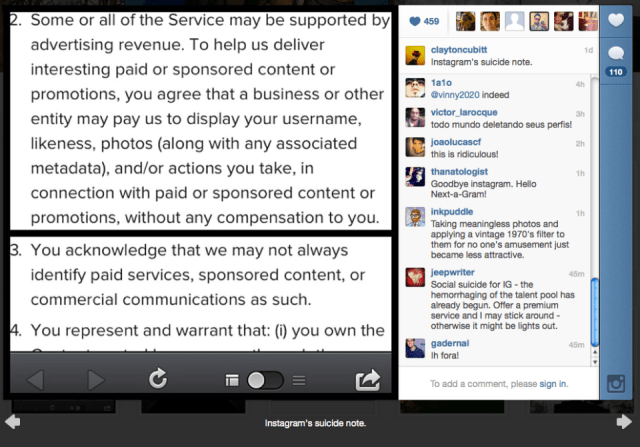You always fear what you don’t understand. – Gotham City mob boss Carmine Falconi.
Tech companies need to wise up and end the cycle of pushing policy updates in confusing legal terms, watching press and users alike panic and threaten to jump ship, and then issuing an apology and clarification. The fact is that the outcry is always louder than the apology. People don’t get the memo, and you lose users or at least trust.
This just happened to Instagram today. Sorry, Kevin, but your blog post stating “it is not our intention to sell your photos” is not going to travel nearly as far as the flood of news articles, tweets, and status updates saying the opposite.
At best, people hear both and are confused and weary about Instagram. At worst, they believe their snapshots of their kids are now stock photos up for grabs by any business, and they’re deleting their Instagram accounts right now (or at least making a big stink by threatening to).
Considering Instagram is owned by Facebook, I’m not sure if I should have expected this blunder or if it’s even less understandable. Facebook has been through this ringer more times than anyone. First it had the big Beacon fiasco where Mark Zuckerberg had to issue a formal apology. In the coming years, changes to its legalese-filled Statement Of Rights And Responsibilities were met with confusion. So much so, that eventually Facebook completely redesigned its privacy policy to create a version designed to be understood by anyone.
But with time Facebook has neglected to explain its policy changes in such clear terms and panic returned. Most recently, Facebook proposed some changes to its site governance process and data use policy. Without explanations in layman’s terms, some users thought Facebook was telling them it now owns their content and was changing their privacy controls. Neither were true; it had to publish a set of clarifications and confusion proliferated.
You’d think by now it had learned its lesson and would pass the teachings on to Instagram.”Yo Kev, if you guys are going to change your policies or terms of service, be sure to make it clear what you’re doing and what you’re not.”
But that wasn’t what happened with Instagram’s latest changes. There was just the Terms Of Service itself — long, hard to understand, scary though it shouldn’t have been — and a short Instagram blog post that casually noted “Nothing has changed about your photos’ ownership.”
That doesn’t cut it. And depending on how you interpret the use of your name and a photo of your face in advertising, it’s not entirely true either. People misunderstood the changes, freaked out, and posted photos of the TOS calling it Instagram’s suicide note. The reality is Instagram doesn’t claim to own your photos, be able to sell them, or plan to use your photos as ads themselves.

So tech companies, let’s stop this. Some of you, including Google, Tumblr, and even Facebook (with its red-lined policy change documents), are making strides in the right direction. But it’s time for all of you to do your users right and go the extra mile to explain exactly what’s going on in a way that doesn’t confuse people. This isn’t easy, but here’s my suggestion for doing this a little better than you are now.
How To Release An Update To Your Terms Of Service
First, give a brief summary of the changes in the most accessible terms possible. Spell out what’s changing and what’s important. This is the layman’s explanation, designed to be understood by anyone who uses your service.
Second, explain every change line by line in relatively comprehensible terms. This is the translation of the legalese into English. In fact, it should be the translation of the legalese into Chinese, Spanish, and Arabic. If a user has a question about what’s going on, this companion to the legal documents should answer it.
Third, provide a red-lined version highlighting the changes on the actual legally binding document. For good measure, offer a link to the old version of your documents, too. These give legal eagles and serious journalists the final word on what’s going on, and it can be used to settle disputes.
Finally, talk to the press. Don’t just spring the changes and leave them open to misinterpretation. Call up a few writers before you publish the announcement or push the changes live and explain what you’re doing. Listen to their questions about what they are confused about, and consider whether your announcement and documents answer these without you. This will also help make sure the first articles about your changes are accurate, and lead other writers who follow in the right direction.
People will assume the worst, so bust the myths before they start.
[Image Credit: AllMoviePhoto / Batman Begins / Warner Bros. Studios]
